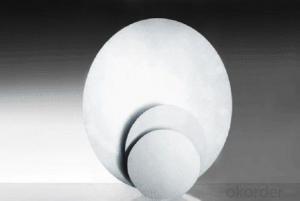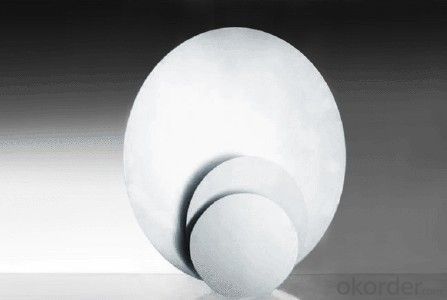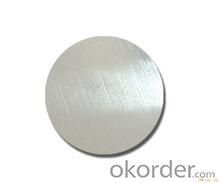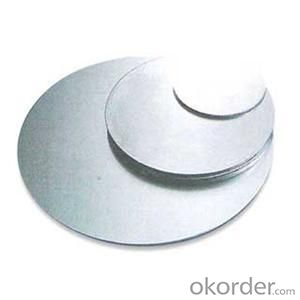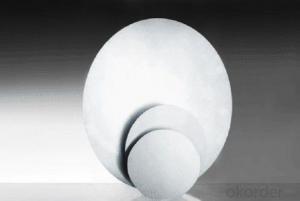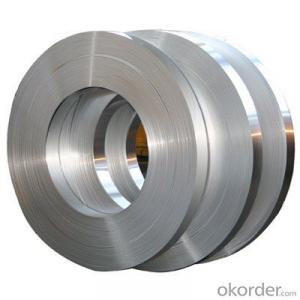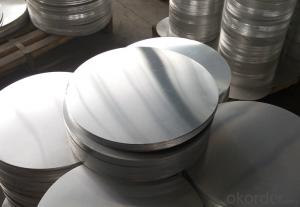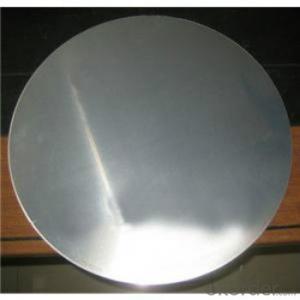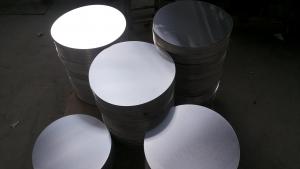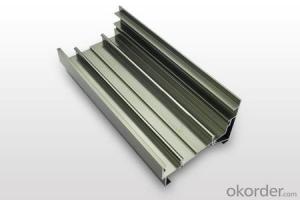Perforated Aluminum Circles for Any Use
- Loading Port:
- China Main Port
- Payment Terms:
- TT OR LC
- Min Order Qty:
- -
- Supply Capability:
- -
OKorder Service Pledge
OKorder Financial Service
You Might Also Like
Aluminium alloys with a wide range of properties are used in engineering structures. Alloy systems are classified by a number system (ANSI) or by names indicating their main alloying constituents (DIN and ISO).
The strength and durability of aluminium alloys vary widely, not only as a result of the components of the specific alloy, but also as a result of heat treatments and manufacturing processes. A lack of knowledge of these aspects has from time to time led to improperly designed structures and gained aluminium a bad reputation.
One important structural limitation of aluminium alloys is their fatigue strength. Unlike steels, aluminium alloys have no well-defined fatigue limit, meaning that fatigue failure eventually occurs, under even very small cyclic loadings. This implies that engineers must assess these loads and design for a fixed life rather than an infinite life.
Another important property of aluminium alloys is their sensitivity to heat. Workshop procedures involving heating are complicated by the fact that aluminium, unlike steel, melts without first glowing red. Forming operations where a blow torch is used therefore require some expertise, since no visual signs reveal how close the material is to melting. Aluminium alloys, like all structural alloys, also are subject to internal stresses following heating operations such as welding and casting. The problem with aluminium alloys in this regard is their low melting point, which make them more susceptible to distortions from thermally induced stress relief. Controlled stress relief can be done during manufacturing by heat-treating the parts in an oven, followed by gradual cooling—in effect annealing the stresses.
The low melting point of aluminium alloys has not precluded their use in rocketry; even for use in constructing combustion chambers where gases can reach 3500 K. The Agena upper stage engine used a regeneratively cooled aluminium design for some parts of the nozzle, including the thermally critical throat region.
Another alloy of some value is aluminium bronze (Cu-Al alloy).
Aluminium foil acts as a total barrier to light and oxygen (which cause fats to oxidise or become rancid), odours and flavours, moistness, and germs, it is used broadly in food and pharmaceutical packaging. The purpose of aluminium is to make long-life packs (aseptic processing|aseptic packaging) for drinks and dairy goods, which allows storing without refrigeration. Aluminium foil containers and trays are used to bake pies and to pack takeaway meals, ready snacks and long life pet foods.
Aluminium foil is widely sold into the consumer market, often in rolls of 500 mm (20 in) width and several metres in length.It is used for wrapping food in order to preserve it, for example, when storing leftover food in a refrigerator (where it serves the additional purpose of preventing odour exchange), when taking sandwiches on a journey, or when selling some kinds of take-away or fast food. Tex-Mex restaurants in the United States, for example, typically provide take-away burritos wrapped in aluminium foil.
Aluminium foils thicker than 25 μm (1 mil) are impermeable to oxygen and water. Foils thinner than this become slightly permeable due to minute pinholes caused by the production process.
- Q: im about to get a grinder online, and i dont know if i should get an aluminum one, or a non aluminum one. cuz i dont know what non aluminum grinders are made out of. thanks
- they can be made outta plastic or wood, prboably something else..but i can't thnk of it. ive had a plastic 1 and it still worked great..even though it was the ch eapest grinder in the store. so..personal preference really. gl
- Q: Are aluminum sheets suitable for electrical busbars?
- Yes, aluminum sheets can be suitable for electrical busbars. Aluminum is a widely used material in the electrical industry due to its excellent electrical conductivity, lightweight nature, and affordability compared to other metals like copper. Aluminum sheets can be easily fabricated into the desired shape and size required for busbars, making them a versatile choice for electrical applications. Additionally, aluminum has good thermal conductivity, which helps in dissipating heat generated during electrical operations. However, it is important to note that aluminum has a lower electrical conductivity compared to copper, so it may require larger cross-sectional areas to achieve the same electrical performance. It is essential to consider the specific requirements of the electrical system and consult with experts to determine if aluminum sheets are suitable for a particular busbar application.
- Q: Can aluminum sheets be used for insulation cladding?
- Yes, aluminum sheets can be used for insulation cladding. Aluminum is a popular choice for cladding material due to its durability, lightweight nature, and resistance to corrosion. It acts as a protective layer for insulation materials, providing thermal insulation, weather resistance, and aesthetic appeal to buildings.
- Q: Are aluminum sheets suitable for food preparation surfaces?
- Aluminum sheets are indeed suitable for food preparation surfaces. They are a lightweight and durable option extensively utilized in the food industry. Being non-toxic and non-reactive, aluminum does not pose any risk of releasing harmful chemicals upon contact with food. Moreover, aluminum sheets are highly convenient to clean and maintain, making them a preferred choice for both commercial and home kitchens. Furthermore, aluminum boasts excellent heat conductivity, ensuring even cooking and baking. Nevertheless, it is worth mentioning that aluminum may react with acidic or salty foods, resulting in a metallic taste. To prevent this, it is advisable to place a layer of parchment paper or a silicone baking mat as a barrier between the aluminum sheet and the food.
- Q: What are the different methods for punching aluminum sheets?
- There exist numerous techniques for punching aluminum sheets, each possessing its own advantages and applications. Among the different methods are: 1. Manual Punching: This approach entails using handheld tools like handheld punches or hole punches to manually create holes or shapes in the aluminum sheet. It is appropriate for small-scale or low-volume production and provides flexibility in terms of hole size and shape. 2. Mechanical Punching: Mechanical punching involves the utilization of a mechanical press machine equipped with a punch and die set. The sheet is inserted into the machine, and the punch is driven through the material, forming holes or shapes. This technique is quicker and more efficient than manual punching and is fit for medium to high-volume production. 3. CNC Punching: Computer Numerical Control (CNC) punching involves the utilization of automated machinery programmed to punch holes or shapes based on a digital design. The aluminum sheet is loaded onto the machine, and the CNC controls the movement of the punch and die to create precise and intricate patterns. CNC punching offers high accuracy, repeatability, and speed, making it ideal for high-volume production and intricate designs. 4. Laser Punching: Laser punching combines the use of a laser cutter and a mechanical punch to produce holes or shapes in aluminum sheets. The laser beam vaporizes or melts the material, while the punch ejects the cut part from the sheet. This method offers high precision, versatility, and the ability to swiftly cut complex shapes. However, it is typically more expensive and time-consuming compared to other methods. 5. Notching: Notching is a technique employed to create V-shaped or U-shaped cuts in aluminum sheets. It is often used for joining or folding the material to form corners or edges. Notching can be done manually or with the assistance of a mechanical notching machine. The selection of a punching method relies on various factors such as the desired hole size and shape, production volume, precision requirements, complexity of design, and budget. It is crucial to consider these factors and consult with experts to determine the most suitable method for punching aluminum sheets based on specific needs and applications.
- Q: Can the aluminum sheets be used for architectural cladding?
- Indeed, architectural cladding can make use of aluminum sheets. Owing to its lightweight properties, durability, and versatility, aluminum remains a favored selection for cladding purposes. Its pliability and ability to assume diverse forms make it ideal for a broad spectrum of architectural designs. Furthermore, aluminum boasts corrosion resistance, ensuring its longevity as a cladding option. Moreover, the possibility of coating aluminum in various finishes enables customization to align with the desired aesthetic of the structure. All things considered, aluminum sheets emerge as a dependable and pragmatic choice for architectural cladding.
- Q: Can aluminum sheet be used for architectural façade systems?
- Yes, aluminum sheet can be used for architectural façade systems. Aluminum is a versatile material that offers durability, lightweight properties, and ease of installation, making it suitable for constructing attractive and functional façades in various architectural designs.
- Q: Are aluminum sheets suitable for use in electrical applications?
- Yes, aluminum sheets are suitable for use in electrical applications. Aluminum is an excellent conductor of electricity, and its high conductivity allows for efficient transmission of electrical current. Aluminum sheets are commonly used in electrical applications such as power transmission lines, electrical wiring, and electrical enclosures. Additionally, aluminum is lightweight, which makes it easier to handle and install. It is also resistant to corrosion, which ensures long-term durability and reliability in electrical systems. However, it is important to note that aluminum has a lower conductivity compared to copper, so it may require larger gauge sizes to compensate for this difference. Overall, aluminum sheets are a viable and cost-effective option for various electrical applications.
- Q: What are the different types of alloys used in aluminum sheets?
- There are several different types of alloys used in aluminum sheets, each offering unique properties and benefits. Some of the most common alloys include: 1. 3003 alloy: This alloy is commonly used in general-purpose applications due to its excellent formability, corrosion resistance, and weldability. It is often used for cooking utensils, signage, and chemical equipment. 2. 5052 alloy: Known for its high strength and good corrosion resistance, the 5052 alloy is commonly used in marine and automotive applications. It is also used for sheet metal fabrication and structural components. 3. 6061 alloy: This alloy is highly versatile and is used in a wide range of applications, including aerospace, automotive, and structural components. It offers excellent strength, machinability, and weldability. 4. 7075 alloy: Primarily used in aerospace and high-strength applications, the 7075 alloy is known for its exceptional strength-to-weight ratio. It is often used in aircraft fittings, gears, and bike frames. 5. 2024 alloy: Another popular alloy in aerospace applications, the 2024 alloy boasts a high strength-to-weight ratio and excellent fatigue resistance. It is commonly used for aircraft structures, bolts, and rivets. 6. 5083 alloy: This alloy is specifically designed for marine applications due to its outstanding corrosion resistance and high strength. It is often used for boat hulls and structural components. These are just a few examples of the various alloys used in aluminum sheets. Each alloy has its own unique combination of properties, allowing it to excel in specific applications.
- Q: How does aluminum sheet perform in outdoor applications?
- Aluminum sheet performs exceptionally well in outdoor applications due to its inherent corrosion resistance and durability. It is highly resistant to rust and can withstand exposure to harsh weather conditions, making it ideal for outdoor structures, signage, and cladding. Additionally, aluminum sheets can be coated or painted to enhance their weather resistance and aesthetic appeal. Overall, aluminum sheet is a reliable and long-lasting material for various outdoor applications.
Send your message to us
Perforated Aluminum Circles for Any Use
- Loading Port:
- China Main Port
- Payment Terms:
- TT OR LC
- Min Order Qty:
- -
- Supply Capability:
- -
OKorder Service Pledge
OKorder Financial Service
Similar products
Hot products
Hot Searches
Related keywords
